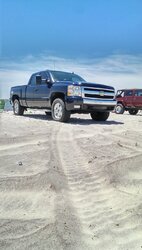I have a 2013 Silverado 1500. Since I tow a lot (race car), the first thing I do with a tow vehicle is set it up for towing and hauling. In my case the first modification I made was to add the Firestone Ride-Rite air springs. Keeping the truck level under various load conditions is one of the first rules, along with having the proper tires and inflation.
I found the 1500 model with air springs is a great combination. The truck is very stable for a 1 ton load of pellets even at freeway speeds. In tow/haul transmission mode, the 5.3L even drops into 4 cyl mode on the flat or downhill areas in 5th gear (it tends not to use 6th in T/H) and provides decent mileage. My pellet source is 60 miles away so I have to drive a ways. I inflate the air springs to 40 psi for the load; they are rated for something like 80 or 100 psi.
In contrast, my previous truck - a 2002 Avalanche - was a decent tow vehicle but rather poor at hauling. It had a lower overall capacity, and the rear springs were coil not leaf. Even with the Firestone air bags inside the rear coils at max pressure, the ride was still not as stable as I wanted for a 1 ton load.
So I find regular pickups are fine with some basic setup, but an SUV vehicle on a similar chassis may not be as suitable.
I found the 1500 model with air springs is a great combination. The truck is very stable for a 1 ton load of pellets even at freeway speeds. In tow/haul transmission mode, the 5.3L even drops into 4 cyl mode on the flat or downhill areas in 5th gear (it tends not to use 6th in T/H) and provides decent mileage. My pellet source is 60 miles away so I have to drive a ways. I inflate the air springs to 40 psi for the load; they are rated for something like 80 or 100 psi.
In contrast, my previous truck - a 2002 Avalanche - was a decent tow vehicle but rather poor at hauling. It had a lower overall capacity, and the rear springs were coil not leaf. Even with the Firestone air bags inside the rear coils at max pressure, the ride was still not as stable as I wanted for a 1 ton load.
So I find regular pickups are fine with some basic setup, but an SUV vehicle on a similar chassis may not be as suitable.





 I also change the fluid every 3 years in my truck's rear end.
I also change the fluid every 3 years in my truck's rear end.